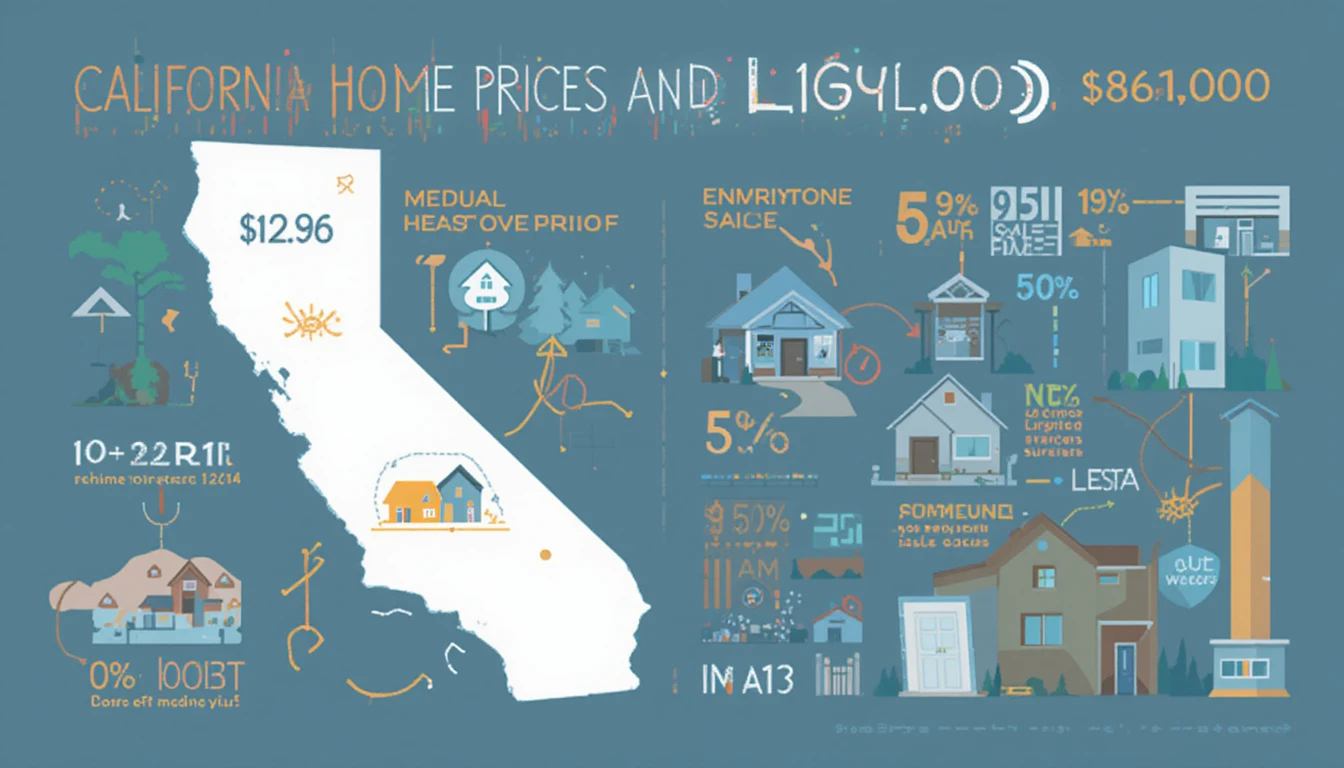By Mohsin Ali
If you’re looking to buy a home in California this year, Jason Walter has both good and bad news for you.
In this blog, Jason Walter shares his insights on the current state of the California real estate market.
Let’s start with the bad news. The bad news is that, despite elevated mortgage rates, California’s home prices are also still on the rise.
However, the good news is that housing inventory is also on the rise as well, which is giving more negotiating power to home buyers. So, for example, homes on average are selling for slightly less than the seller’s asking price.
I’m going to share exactly what’s happening right now in the California housing market.
The information that I am providing is from a new report from the California Association of Realtors. I’ll provide a high-level overview about what’s happening right now.
We’re going to talk about single-family existing houses, therefore excluding brand-new homes.
California Housing Market Sales and Prices
So, for the month of December, home sales increased by nearly 20% compared to December of 2023. We’ll talk about that here in a little bit. Based on home prices, or the median sold price in California, that’s $861,000, an increase of 5% year-over-year.
That’s basically twice as high compared to the national average at around $400,000. So, we definitely pay to live in California. The month supply is at 2.7 months. That is an increase of nearly 4% year-over-year, but actually a decrease compared to the previous month.
So, for example, back in November, the month supply was at 3.3 months. Now, it decreased quite a bit, down to 2.7 this December. And the significance regarding this is that a more balanced housing market is in the range of four to five months, not 2.7 months.
Every market’s different. I’ll share county-level stats in my next video, which I’ll post here very soon. Also, based on the median days in the market, how fast or how slow houses are selling, it’s taking around four weeks to sell a house because days in the market’s at 31 days.
That is a big increase compared to a year ago, up by 19%. But looking at the actual number of days, it’s not a big difference. So, for example, back in December of 2023, it took about 5 days faster to sell a house. So, it’s only taking about 5 days longer right now.

Home Sales Trends and Price Projections
Okay, let’s talk about home sales, and we’ll talk about home prices here very, very soon. So, here’s something that really caught my attention. Actually, it’s two things, really. So, looking at the number of closed home sales for the entire year last year compared to previous years, it’s basically the first annual increase in about three years.
So, home sales compared to the previous years have been decreasing for about two years, but last year we saw the first increase in 3 years.
On top of that, based on the seasonally adjusted annualized rate at 268,000 units, so basically they look at the current sales pace in December, multiply that by 12, do a seasonal adjustment.
If you had the same pace of home sales throughout the year, you would have around 268,000 for the year. That, by the way, is a 5-month high, which is unusual, right? Because home sales tend to decrease in December, and here we are at basically the highest levels in about 5 months and again up by 19.8% year-over-year.
Top End of the Market and Affordable Housing Sales
Here’s something we also know as well: sales at the top end of the market are increasing big time, especially when we look at sales at the more affordable range. So, home sales this December compared to 12 months ago surged by 38%.
Sales for over $2 million in the range of $1 million to $2 million, they increased by 26%. And, of course, sales for less than $400,000 are increasing greatly because, of course, our average home price is around $800,000. So, this is overall impacting the statewide median sold price because we’re seeing a strong increase in sales of multi-million-dollar properties, and, of course, decreases at the lower end of the market.
In fact, so much so that around one-third of all home sales this December were for over $1 million. Last year at this time, it was at 29.9%. In contrast, in December 2024, sales for less than $500,000 only represented about 24% of all closed home sales. This last year, in contrast, in December 2024, only 24% of all home sales sold for less than $500,000.

Pending Home Sales and Mortgage Rates
Let’s also have a look at a future projection of closed home sales, that is, pending home sales. When home buyers get their offer accepted, that’s a new pending home sale. That decreases by 1.5% year-over-year.
That’s the first time it has decreased compared to the previous year in about 6 months. This implies that closed home sales in January and also potentially in February could remain relatively low, given that pending’s decreased by 1.5%.
But on top of that, mortgage rates increased quite a bit in January and also in December as well, which could cause a kind of muted effect regarding our housing market here in California and, frankly, nationwide as well.
Long-Term Home Price Trends
Alright, let’s talk about home prices based on the median sold price. That increased compared to the previous year now for 18 consecutive months. So, for 18 consecutive months, home prices have increased.
There was only about, I think, six months in which home prices decreased compared to the previous year, but that was back in what, 2023, early ’23? What also really caught my attention as well is that home prices increased from November to December. It increased by 1%.
This really caught my attention because we are seeing this elevated mortgage rate environment, but despite that, home prices still increased compared to November and, again, up by 5% year-over-year.
Comparing Current Prices to Past Trends
Alright, so I want to share how these numbers compared to years past, and I’m going to kind of provide a shortened version of this because I tend to take a deep dive into this, but I just want to provide a high-level overview about what’s happening right now, how this compares to years past.
So, again, we’re at $861,000, which was the median sold price in California. That is a decrease compared to the all-time record highs that were set back in May of 2024 at $98,000. Something to keep in mind, though, is that home prices tend to decrease in December compared to the spring home buying season. So, I’ll have to see what this looks like once we approach the spring months this year, how it compares to the all-time record high that was set one year ago.

In any case, like I mentioned, home prices increased by 5% year-over-year, and that also marks the 18th consecutive month in which prices rose compared to the previous year. However, it’s lower compared to the longer average. So, for example, based on my nerdy Excel formula there, the average increase from December compared to the previous December, going back to the year of 2010, is a whopping big increase.
I mean, a huge increase, up by 7.6%. So, on average, home prices tend to increase by 7.6% in December, whereas this December it only increased by 5%. This, by the way, is a little bit lower compared to what happened last year. Last year at this time, we were up by 6.4%. But we’re actually much better than the decreases we saw from November of 2022 through June of 2023. Back then, we saw a decrease in the California median sold price from 12 months ago.
In fact, in November of 2022, based on my nerdy analysis here, that was the first year-over-year decrease since February of 2012. So, we saw a real estate market correction in California, but basically only lasted for about 8 months. And then, of course, it increased in July to 2%, which obviously is much lower than the 5% gains we saw this December.
Month-to-Month and Long-Term Price Changes
Also, looking at the month-to-month change, again, like I mentioned, it increased by 1%, quite a bit better than the 4% decrease we saw in November, but a gain of 1%. This is something that really caught my attention as well.
I always thought that home prices tend to decrease in December, but the data doesn’t support that because the average November through December change, the month-to-month change in December, going back to the year of 2010, is an increase of 2.1%, whereas this month it actually increased by only 1%.
Therefore, the big picture regarding this is that home prices are still on the rise, right? But we’re seeing this kind of deceleration in which home prices are increasing but increasing at a lower rate compared to the long-run average.
On top of that, looking at the gain in prices over the past 5 years, we’re seeing an increase of 40%. Back in December of 2019, back then it was only at $614,000.

Negotiation Power and Final List Prices
Alright, if you guys are getting any value on today’s video, then please hit the like button. I appreciate that. Let’s also talk about the sale price to final list price ratio.
As I mentioned at the very beginning of this video, because we’re seeing this rise in inventory levels, home buyers have more negotiating power, and the data kind of supports that because homes on average sold for 98.7% of the seller’s final list price.
This means on average, this December, they sold for 1.3 percentage points less than the seller’s asking price. And also, that ratio at 98.7% is actually the lowest level since February of 2023, and this obviously is much different compared to the peak back in the spring home buying season of ’21 and 2022. Back then, homes on average were selling for nearly 5% over asking. Now, they’re selling for slightly less than the asking price.
Sales Above Asking and Decreases in Over-asking Sales
Now, speaking of that, the share of houses that sold over asking price this December decreased to a 22-month low. This is a little bit deceiving in my opinion because we’re tending again like the housing market tends to kind of slow down in November through really January.
So, the share of houses selling over the seller’s asking price tends to be at a lower share during this time, and tends to be at a higher share compared to the spring home buying season. So, for example, back in April of 2022, 73% of all houses that sold that month sold for over the seller’s asking price.
In contrast, this December, only around one-third sold for over asking. That is a slight decrease compared to 12 months ago. Back then, it was at 34.3%. Also, clearly, as you guys can see, over the past couple of years, the share of houses selling over the seller’s asking price has decreased significantly.
Home Price-to-Income Ratio and Affordability Issues
Alright, one last thing to consider is that the home price-to-income ratio also is a big issue in California. So, when we look at the median home price divided by the median household income, that increased to 7.4 times, and that’s the highest ratio we’ve seen in the state of California since the year 2008.
To put that into context, the historical long-term average is about 4.5 times. In other words, in the past, the median home price used to be about 4.5 times the average household income. And now we’re at 7.4 times. That’s basically the highest ratio we’ve seen since 2008. So, the big question that we all have, will home prices continue to rise this year or will they go down? So, here’s the thing to consider.
I think we could see home prices level off, but I don’t necessarily think they’re going to decrease. Again, I don’t think home prices are going to crash, but will they level off? Absolutely. I think home buyers have more negotiating power now due to rising inventory levels.
That might mean fewer multiple offers, but it might mean more days on the market, which might impact home prices over time. So, like I mentioned, overall, I think prices will level off. However, I don’t necessarily think that prices are going to decrease.




